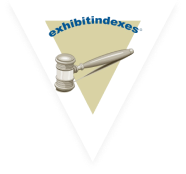23rd Aug 2022
How to make Sure You Have a Properly Attached Document on Your Exhibit
Eliminate any possible errors. Exhibit labels and tables can help make sure your attached document is paired with the correct exhibit at all times.
Preparing for a trial can take months or years of gathering documents, statements, and other types of evidence to prove your case. When fumbling through these documents, especially during the trial, you want to ensure you have the right attached document filed correctly.
When an attorney is efficient and has their documents all appropriately organized, they appear more credible to the jury. Presentation is everything when it comes to working in the courtroom.
To ensure that you have all of your documents in the right place, you may want to consider using exhibit labels or tags. Continue reading below to learn more about these exhibit tags and other best practices to ensure your documents are as organized as possible for your next trial.
Copy and Organize Exhibits
The best way to eliminate any possible errors is to organize your exhibits by using exhibit labels. Placing these labels on your court documents makes it much easier for the court reporter.
It is also best to create a master index of each exhibit. Don't forget to include the document's date, type, author or source, and a short description to identify what the item is.
Having a minimum of three copies of the exhibit documents is best. The original should go into evidence, and the other two should go to your attorney and opposing counsel.
Prepare Electronic Documents
Before introducing an electronic attached document, you may have to print some forms to introduce them as exhibits. If your attorney claims they cannot produce a printed version because it may compromise the authenticity of the legal documents, make sure you prep the original electronic copy for the court.
To ensure you have an easy time locating corresponding documents, be sure to organize your digital exhibit documents as you would with your physical ones. Reference numbers could be the same for digital records.
Use Initials To Identify the Author
Make sure to use exhibit tabs with the initials of the source or the author. This makes it easy for your attorney to correctly identify the exhibit's author or source.
Prep for Trial
As you know, you and your attorney will need to have access to different legal documents throughout the duration of the trial. You most likely won't need to add them to your filing system until you complete the trial. To make that process easy when the time comes, you should create a system for your trial files.
Categories to organize those documents into:
- Research
- Client documents
- Experts
- External correspondence
- Witness information
- Witness statements
- Inter-office memos
- Proceedings and pleadings
Having this information clearly labeled can help with pre-trial proceedings and the filing process when the trial ends. Make sure that contacts for all parties involved are easily accessible. Using custom exhibit tabs makes it easier to separate each category.
Understand Court Requirements
Each court has its own rules for filing certain exhibit documents. It is best to find out each jurisdiction's rules when it comes to filing documents.
You can do this by reaching out to the clerk's office for specific information, especially when it comes to electronic records. Taking the initiative to learn about how to file electronic exhibits can help you avoid problems during the case.
How To Handle Oversized Exhibits
If you have oversized exhibits that you must enter into evidence, it is best to copy and mount the exhibit well in advance. If the large exhibit is a copy of the smaller version, both of them may be marked as an exhibit.
If it is an extract, highlight the portion of the original document that's been enlarged. The original can then be sent to the jury to be used as an illustration. To prevent disrupting the trial flow and avoid appearing unorganized, practice positioning large exhibits in the courtroom before trial.
Make Exhibit Labels
Making exhibit labels that stand out and are easy to identify are critical to a successful trial. This is not only helpful for your attorney but the judge and court employees. There are many different companies that provide labeling products you can customize for your legal documents.
Print label suggestions:
- Plaintiff's exhibit
- State exhibit
- Respondent's exhibit
- Petitioner's exhibit
- Defendant's exhibit
Once you find the right company to partner with, they should be able to help you find the proper labels with the right colors. These labels are easy to affix to your documents and usually come with a blank space so you can insert initials, dates, and exhibit numbers.
Prep for a Possible Appeal
Regardless of if you win or lose your case, your documents provide a record of events. If they are well organized, they are much easier to review. This helps in the event that you need to file an appeal.
Organizing Additional Documents
Having the proper labels in place for an attached document is excellent for submitting court documents and organizing additional supporting documents to the case. When arranging your data, you may want to create a binder for objections to evidence or draft arguments.
Organize and Label Your Attached Document With Ease
There are often several different documents involved in court cases. Even with the best preparation, your attorney may ask for an exhibit in the spur of the moment. When this happens, it is best to remain as calm as possible.
Use exhibit labels to prevent yourself from fumbling when your attorney asks for an attached document. These labels will make it easier to find the information you need immediately. Contact us to learn more about these exhibit labels and which ones to purchase.




